20 Historical Pictures From Around the World You May Not Have Seen.
Nathan Johnson
Published
06/03/2018
in
wow
interesting stories from history
- List View
- Player View
- Grid View
Advertisement
-
1.
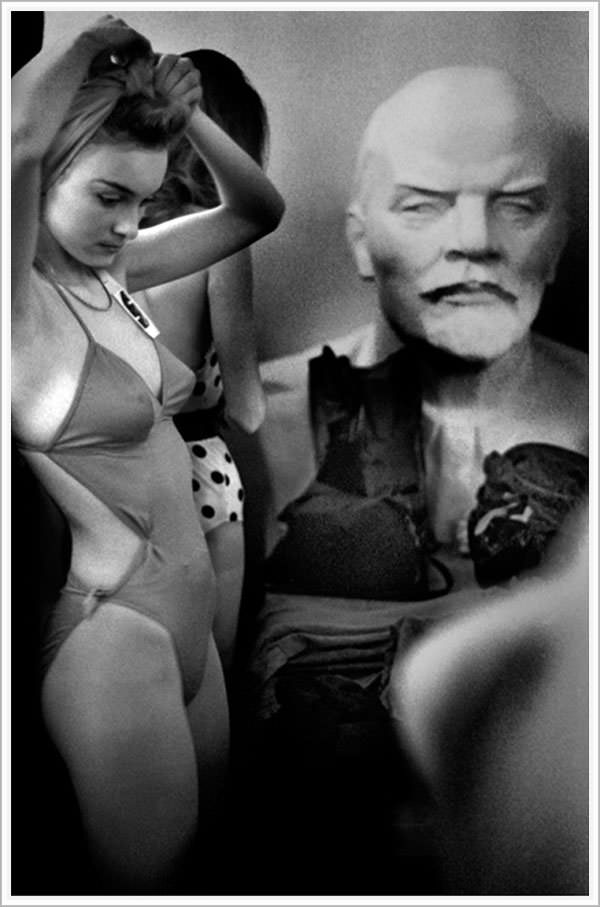 Contestants getting ready for the Miss Soviet Union pageant near a statue of Vladimir Lenin in Moscow, USSR in 1988. This is the first beauty pageant of any kind in the Soviet Union since they were banned in 1959. The USSR had a history of rather conservative views, outlawing anything they deemed too much for long stretches before they collapsed. This including provocative attire or even certain Western clothing, homosexuality, dance and strip clubs, pornography, and plenty more. In the 1980s the USSR removed some of those restrictions, such as beauty pageants. After the collapse and transition to democracy, much more would be allowed throughout Russia and the many countries created afterwards.
Contestants getting ready for the Miss Soviet Union pageant near a statue of Vladimir Lenin in Moscow, USSR in 1988. This is the first beauty pageant of any kind in the Soviet Union since they were banned in 1959. The USSR had a history of rather conservative views, outlawing anything they deemed too much for long stretches before they collapsed. This including provocative attire or even certain Western clothing, homosexuality, dance and strip clubs, pornography, and plenty more. In the 1980s the USSR removed some of those restrictions, such as beauty pageants. After the collapse and transition to democracy, much more would be allowed throughout Russia and the many countries created afterwards. -
2.
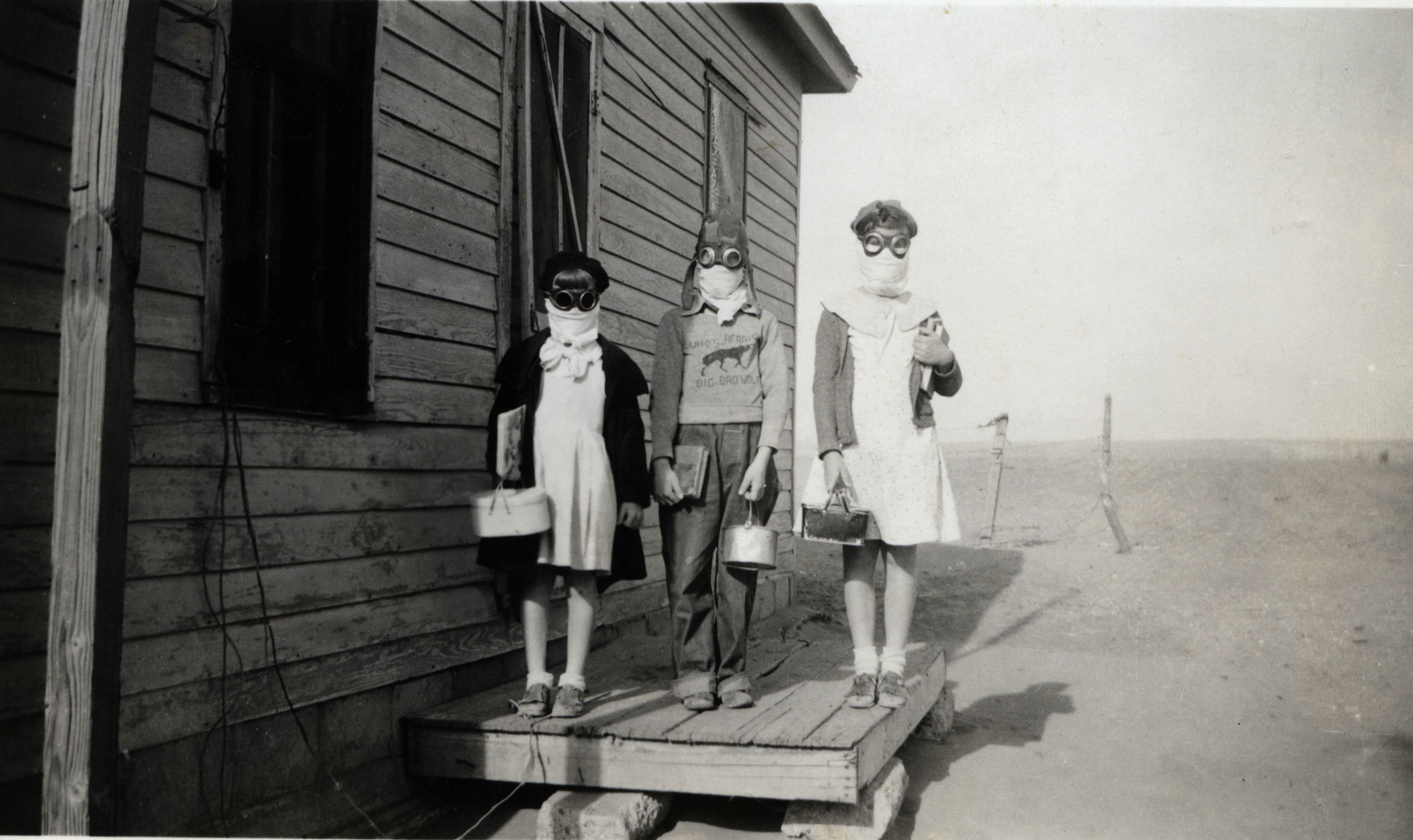 3 Children on their way to school in Oklahoma, US in 1933. This was during the terrible time know as The Dust Bowl, when storms ravaged the area in the 1930s. The storms were saw bad, people could not venture outside without wearing protection. This also heavily affected farming and gave people health issues as well, with some cases causing deaths. Severe drought and a failure to apply dryland farming methods know as the Aeolian process which would prevent wind erosion caused the phenomenon. The key areas affected were parts of Oklahoma, Texas, New Mexico, Colorado and half of Kansas. Poor families in particular had to abandon their homes and land entirely, as they couldn't grow anything and could not pay their mortgages. This was also during the Great Depression, leaving little other options for work in the affected areas. In the 1930s, it is estimated 3.5 million people moved out of the plain states, many to California.
3 Children on their way to school in Oklahoma, US in 1933. This was during the terrible time know as The Dust Bowl, when storms ravaged the area in the 1930s. The storms were saw bad, people could not venture outside without wearing protection. This also heavily affected farming and gave people health issues as well, with some cases causing deaths. Severe drought and a failure to apply dryland farming methods know as the Aeolian process which would prevent wind erosion caused the phenomenon. The key areas affected were parts of Oklahoma, Texas, New Mexico, Colorado and half of Kansas. Poor families in particular had to abandon their homes and land entirely, as they couldn't grow anything and could not pay their mortgages. This was also during the Great Depression, leaving little other options for work in the affected areas. In the 1930s, it is estimated 3.5 million people moved out of the plain states, many to California. -
3.
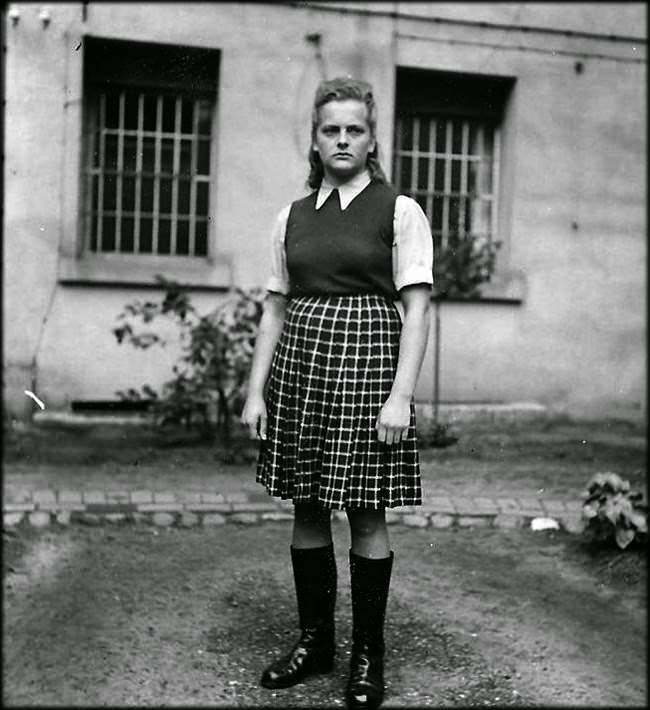 22 Year old SS guard of the Auschwitz concentration camp Irma Ilse defiantly poses for a picture after her capture in 1945. She was also the warden of the womens section of the Bergen-Belsen concentration camp. Many said she had the face of pure evil and showed zero remorse for her crimes which included executions, assisting with Nazi experiments, torture, beatings, and much more. Originally she wanted to be a nurse, but she failed all her tests. She became infatuated with the Nazi's and volunteered for SS guard duty. She went from wanting to try to save people to killing them. She would be hung for war crimes later that year.
22 Year old SS guard of the Auschwitz concentration camp Irma Ilse defiantly poses for a picture after her capture in 1945. She was also the warden of the womens section of the Bergen-Belsen concentration camp. Many said she had the face of pure evil and showed zero remorse for her crimes which included executions, assisting with Nazi experiments, torture, beatings, and much more. Originally she wanted to be a nurse, but she failed all her tests. She became infatuated with the Nazi's and volunteered for SS guard duty. She went from wanting to try to save people to killing them. She would be hung for war crimes later that year. -
4.
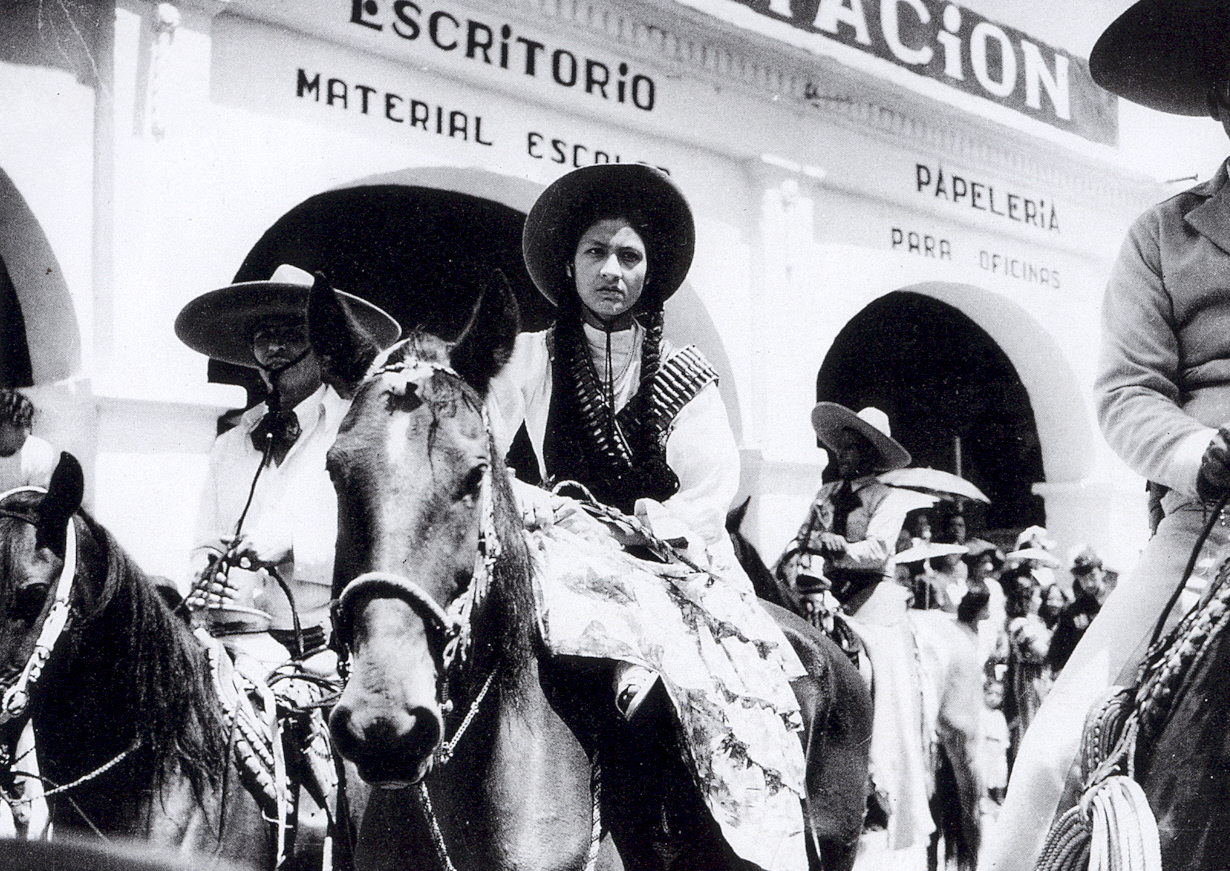 A female rebel soldier known as a Soldadera in Mexico in 1911. During the Mexican revolution, women and children were heavily involved in the revolutionary army. In the beginning, the US supported the Mexican government, and made it more difficult for the revolutionaries to get supplies and men for the fight. So they grabbed anyone willing to fight or whom they could force/trick into fighting. Women, children as young as 8, anyone. They also began a campaign of attacking armories, including US armories for supplies. After about 4 years, the US actually switched sides, and supported the rebels, changing the dynamics of the war. The US even sent troops into Mexico to fight. A major country so close able to supply the rebels gave them the upper hand, and in 1920, after nearly 10 years of war, the revolutionaries won. An interesting note about the US involvement in Mexico; during WWI, Germany knew the US joining the allies was a big problem for them. They contacted the Mexican government and asked them to join the German side, going to war with the US, and once they won, Mexico would receive all lost lands from the US including parts of Arizona, New Mexico, California, and of course Texas. The US actually uncovered this plan before Mexico had made a decision. With their own problems, the Mexican government was not crazy and desperate enough to join the Germans and go to war with the powerful US anyway.
A female rebel soldier known as a Soldadera in Mexico in 1911. During the Mexican revolution, women and children were heavily involved in the revolutionary army. In the beginning, the US supported the Mexican government, and made it more difficult for the revolutionaries to get supplies and men for the fight. So they grabbed anyone willing to fight or whom they could force/trick into fighting. Women, children as young as 8, anyone. They also began a campaign of attacking armories, including US armories for supplies. After about 4 years, the US actually switched sides, and supported the rebels, changing the dynamics of the war. The US even sent troops into Mexico to fight. A major country so close able to supply the rebels gave them the upper hand, and in 1920, after nearly 10 years of war, the revolutionaries won. An interesting note about the US involvement in Mexico; during WWI, Germany knew the US joining the allies was a big problem for them. They contacted the Mexican government and asked them to join the German side, going to war with the US, and once they won, Mexico would receive all lost lands from the US including parts of Arizona, New Mexico, California, and of course Texas. The US actually uncovered this plan before Mexico had made a decision. With their own problems, the Mexican government was not crazy and desperate enough to join the Germans and go to war with the powerful US anyway. -
5.
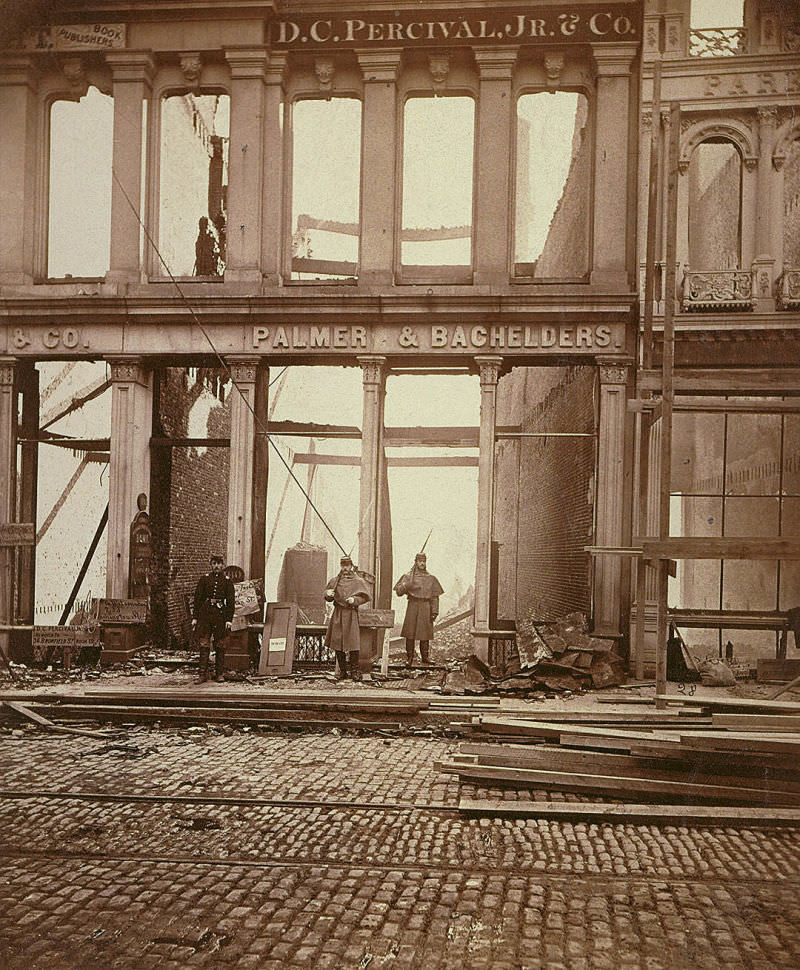 Soldiers on watch to prevent looting after the Great Boston Fire in 1872. The fire began in a commercial buildings basement. It moved incredibly fast, and it destroyed 776 buildings over 65 acres in just 12 hours. Much of the financial district was burned to the ground, costing $73.5 million in damage (that's $1.5 billion today). The timing and fast action did prevent deaths, as only 13 people died in the blaze, but no city authority existed at the time to enforce building codes, meaning many of the buildings were old and prone to fire. As with many protection measures in the US, a major avoidable disaster has to take place before action is actually taken.
Soldiers on watch to prevent looting after the Great Boston Fire in 1872. The fire began in a commercial buildings basement. It moved incredibly fast, and it destroyed 776 buildings over 65 acres in just 12 hours. Much of the financial district was burned to the ground, costing $73.5 million in damage (that's $1.5 billion today). The timing and fast action did prevent deaths, as only 13 people died in the blaze, but no city authority existed at the time to enforce building codes, meaning many of the buildings were old and prone to fire. As with many protection measures in the US, a major avoidable disaster has to take place before action is actually taken. -
6.
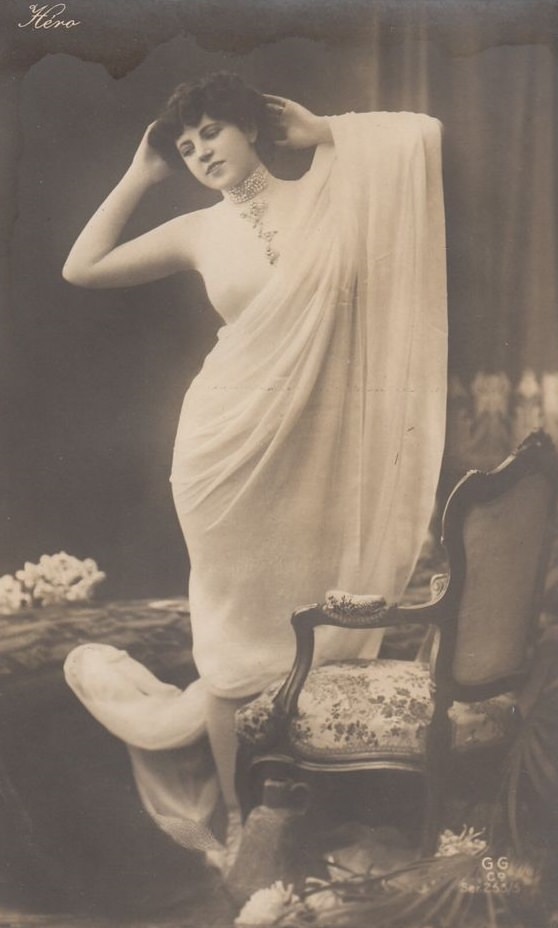 A German risque postcard from 1905. Unlike the French, the Germans often had more tamed postcards such as this during the time. The French put naked women and sexual acts on postcards the moment they could. The Germans put pictures similar to the one shown, with a few known examples of naked ladies, but whether they were traded publicly like the French ones is debatable. The Americans had such pictures as well, but were outlawed, and traded privately. American nude photography really ramped up in the 1920s, but again, was mostly traded privately as such smut was outlawed in the US until around 1950. During WWI, when the Germans captured French positions, they would find their postcards, and saw they showed a lot more on average than the German ones. Soon they became a hot trading item on all sides.
A German risque postcard from 1905. Unlike the French, the Germans often had more tamed postcards such as this during the time. The French put naked women and sexual acts on postcards the moment they could. The Germans put pictures similar to the one shown, with a few known examples of naked ladies, but whether they were traded publicly like the French ones is debatable. The Americans had such pictures as well, but were outlawed, and traded privately. American nude photography really ramped up in the 1920s, but again, was mostly traded privately as such smut was outlawed in the US until around 1950. During WWI, when the Germans captured French positions, they would find their postcards, and saw they showed a lot more on average than the German ones. Soon they became a hot trading item on all sides. -
7.
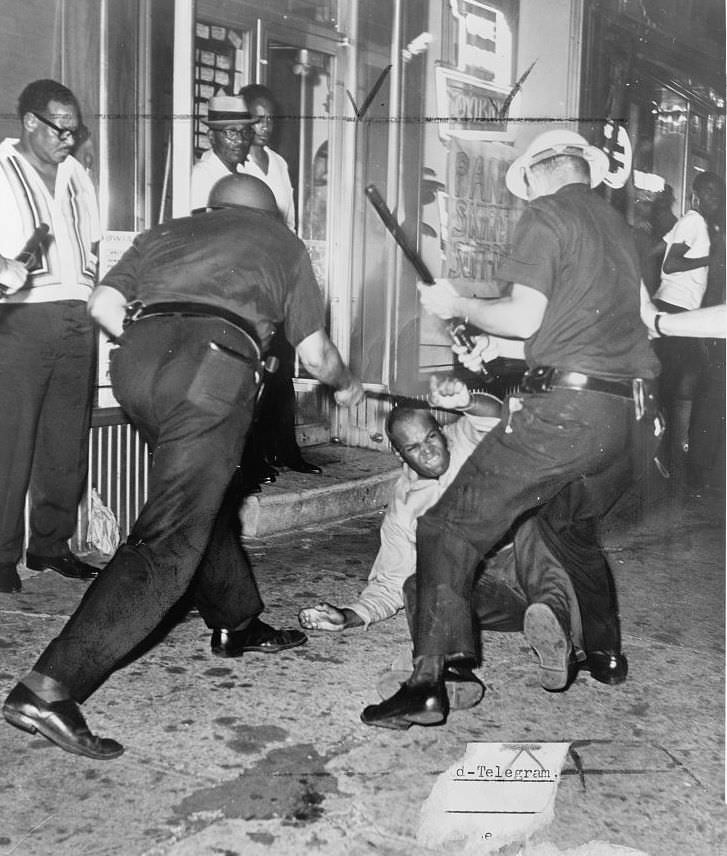 A protester is beaten during the beginning of the Harlem Riots in NYC, US in 1964. The riots began when a 15 year old unarmed black boy, James Powell, was gunned down by Lieutenant Gilligan in front of Powells friends and other witnesses. At first, 300 students protested, then the entire borough of Harlem started protesting. The police began pushing them back with beatings but had to retreat as the protesters turned to rioters. The riots went on for 6 straight nights, damaging much of Harlem itself. It was finally quelled. One rioter was killed, with 118 wounded and nearly 500 arrested. It was estimated some 4,000 partook in the riots. Unfortunately, as with most documented race riots in the US, almost all the damage accumulated affected businesses and homes owned by other black people.
A protester is beaten during the beginning of the Harlem Riots in NYC, US in 1964. The riots began when a 15 year old unarmed black boy, James Powell, was gunned down by Lieutenant Gilligan in front of Powells friends and other witnesses. At first, 300 students protested, then the entire borough of Harlem started protesting. The police began pushing them back with beatings but had to retreat as the protesters turned to rioters. The riots went on for 6 straight nights, damaging much of Harlem itself. It was finally quelled. One rioter was killed, with 118 wounded and nearly 500 arrested. It was estimated some 4,000 partook in the riots. Unfortunately, as with most documented race riots in the US, almost all the damage accumulated affected businesses and homes owned by other black people. -
8.
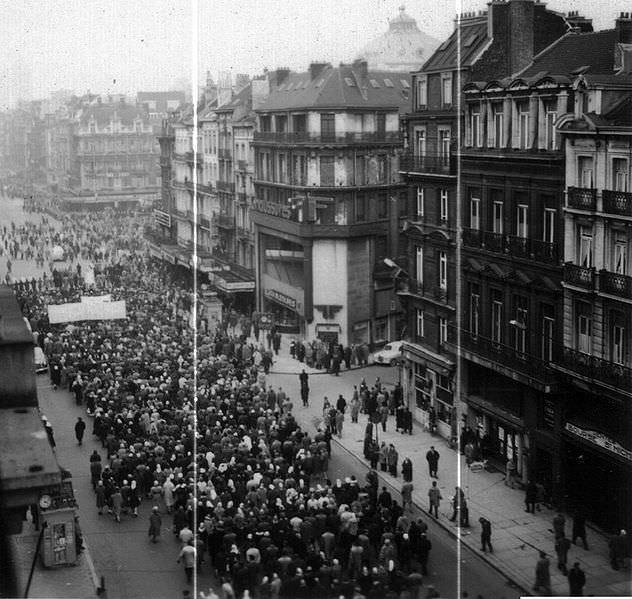 People taking part in a general strike line the city of Brussels, Belgium in 1960. The strike occurred over 6 weeks in the winter of 1960-61 against the the proposed Law on Economic Growth, Social Progress and Fiscal Redressment. The law was designed to reduce Belgium’s large government debt and to respond to the independence of the Belgian Congo in 1960. Around 700,000 workers went out on strike out of a countries entire population of 9.1 million, shutting down key areas for weeks. Unfortunately, the various groups of workers were not in perfect unison, and factions broke off and went back to work shortly after the strikes began. This gave the general strike problems, and after 6 weeks it failed. The law did pass in 1961 regardless of these actions, but some other major political changes did arise in Belgium with such powerful demonstrations.
People taking part in a general strike line the city of Brussels, Belgium in 1960. The strike occurred over 6 weeks in the winter of 1960-61 against the the proposed Law on Economic Growth, Social Progress and Fiscal Redressment. The law was designed to reduce Belgium’s large government debt and to respond to the independence of the Belgian Congo in 1960. Around 700,000 workers went out on strike out of a countries entire population of 9.1 million, shutting down key areas for weeks. Unfortunately, the various groups of workers were not in perfect unison, and factions broke off and went back to work shortly after the strikes began. This gave the general strike problems, and after 6 weeks it failed. The law did pass in 1961 regardless of these actions, but some other major political changes did arise in Belgium with such powerful demonstrations. -
9.
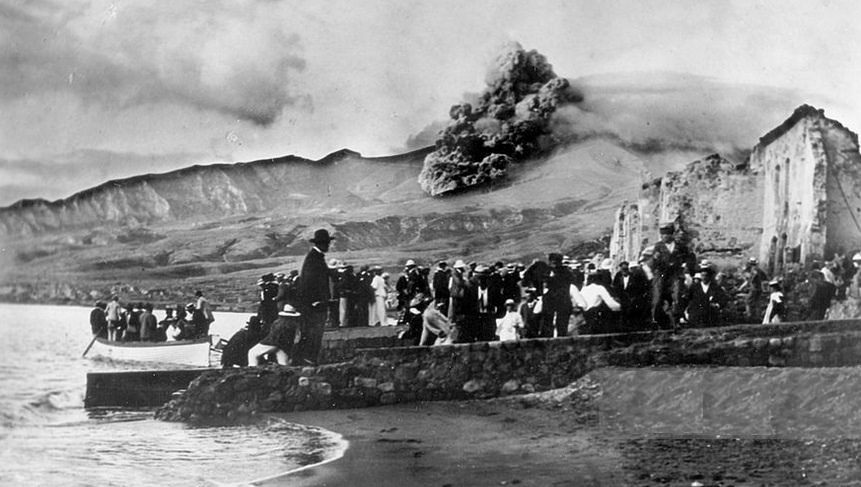 People board the last few ships available as the volcanic cloud moves towards them during an early eruption of Mount Pelée on the island of Martinique in 1902. Anyone unable to get off the island went to the city of Sait-Pierre. The city was flooded with too many refugees fleeing other parts of the island as smaller eruptions had already begun. These people had no other place to go at this time. Before a major plan could commence to potentially evacuate Sait-Pierre of its large population, the main eruption hit the city and it hit hard and fast. The eruption quickly engulfed the entire city of Sait-Pierre, killing virtually all the 30,000 people in the city at the time. Apparently only 2 people survived. The people had no chance, and this was the 3rd worst death toll from a volcano in recorded history.
People board the last few ships available as the volcanic cloud moves towards them during an early eruption of Mount Pelée on the island of Martinique in 1902. Anyone unable to get off the island went to the city of Sait-Pierre. The city was flooded with too many refugees fleeing other parts of the island as smaller eruptions had already begun. These people had no other place to go at this time. Before a major plan could commence to potentially evacuate Sait-Pierre of its large population, the main eruption hit the city and it hit hard and fast. The eruption quickly engulfed the entire city of Sait-Pierre, killing virtually all the 30,000 people in the city at the time. Apparently only 2 people survived. The people had no chance, and this was the 3rd worst death toll from a volcano in recorded history. -
10.
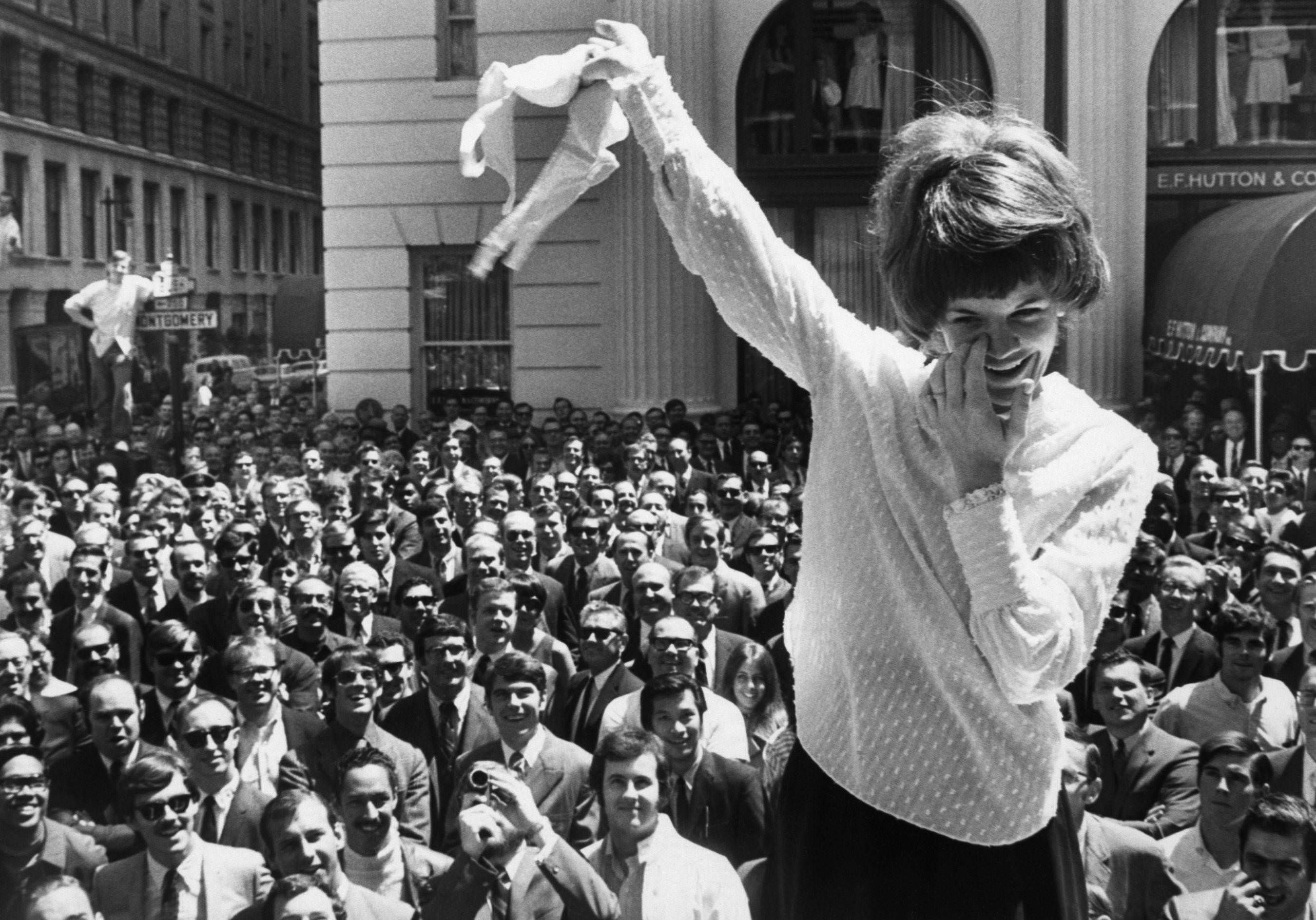 A woman removes her bra to the joy of the crowd outside a department store in San Fransisco, US in 1969. During the late 1960s and early 1970s, a number of different movements existed in the US. The anti-Vietnam movement, the Civil Rights Movement, and the Womens movement were the bigger ones. The last 2 pushed for equality in a country run predominantly by white males at the time. One of the staples of the womens movement at the time was removing their bras and on occasion, burning them. This was a sign of a womans liberation from the stigma of just being an object of affection.
A woman removes her bra to the joy of the crowd outside a department store in San Fransisco, US in 1969. During the late 1960s and early 1970s, a number of different movements existed in the US. The anti-Vietnam movement, the Civil Rights Movement, and the Womens movement were the bigger ones. The last 2 pushed for equality in a country run predominantly by white males at the time. One of the staples of the womens movement at the time was removing their bras and on occasion, burning them. This was a sign of a womans liberation from the stigma of just being an object of affection. -
11.
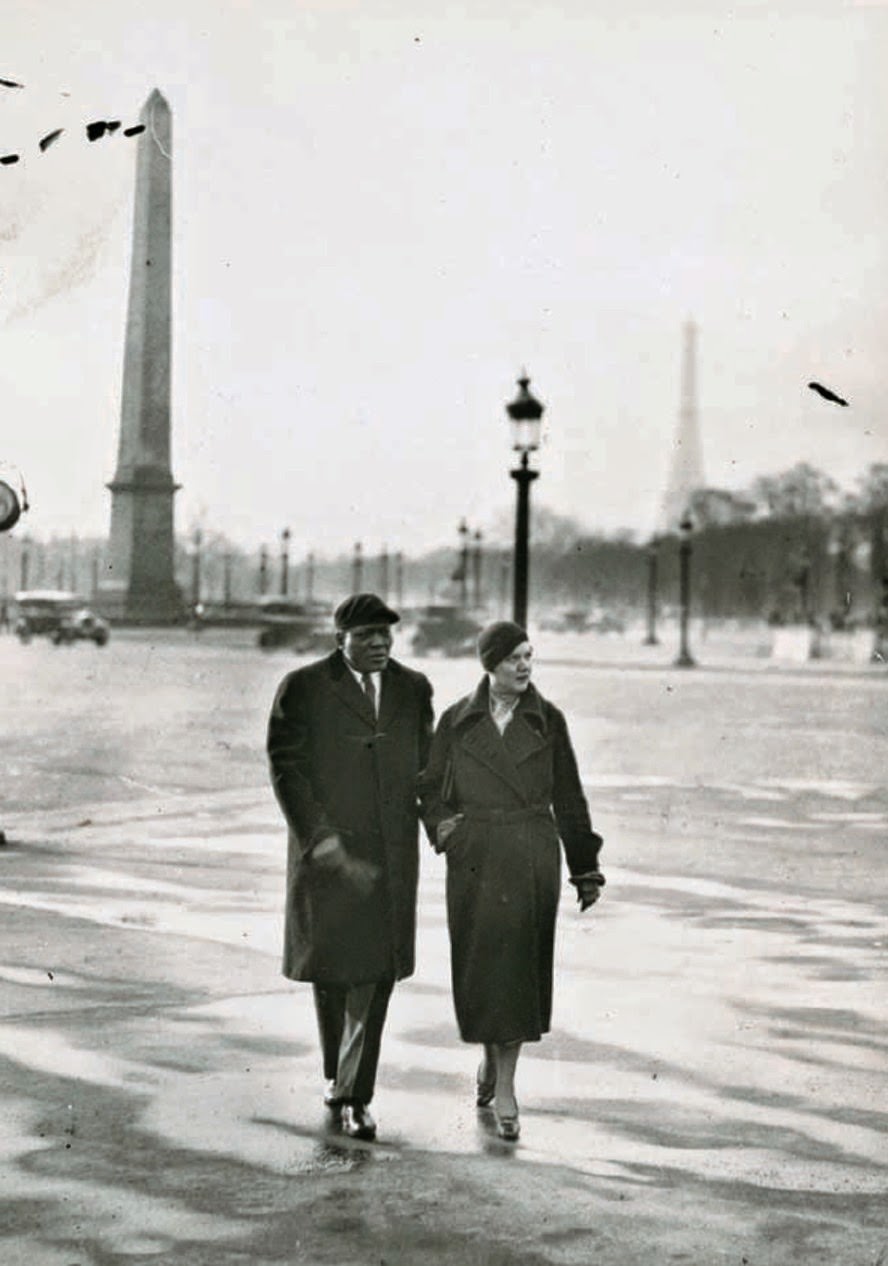 Jack Johnson and his third wife Irene Pineau in Paris, France in 1930. Irene is in fact white. In 1908, Johnson became the first black heavyweight boxing champion. He would reign for the next 7 years. Unfortunately, 1912 would prove a difficult year for the champion. First, he opened a desegregated club and was known for his relationships and marriages to white women (all 3 of his wives were white). This led to the government going after him for violating racially charged laws. Also that same year, his first wife Etta actually killed herself supposedly because Johnson was sleeping around on her. Also it is rumored he would verbally abusive with her and flaunted his infidelity. He would fight the legal battle for a year before fleeing to France in 1913. He actually remained oversees through WWI, returning in 1920 and serving his year conviction for transporting a woman across state lines for immoral purposes. He would visit France often, and even fought as a boxer into his 60s, losing most of his fights at that age. He died in a car accident in 1946. President Trump pardoned his conviction earlier this year.
Jack Johnson and his third wife Irene Pineau in Paris, France in 1930. Irene is in fact white. In 1908, Johnson became the first black heavyweight boxing champion. He would reign for the next 7 years. Unfortunately, 1912 would prove a difficult year for the champion. First, he opened a desegregated club and was known for his relationships and marriages to white women (all 3 of his wives were white). This led to the government going after him for violating racially charged laws. Also that same year, his first wife Etta actually killed herself supposedly because Johnson was sleeping around on her. Also it is rumored he would verbally abusive with her and flaunted his infidelity. He would fight the legal battle for a year before fleeing to France in 1913. He actually remained oversees through WWI, returning in 1920 and serving his year conviction for transporting a woman across state lines for immoral purposes. He would visit France often, and even fought as a boxer into his 60s, losing most of his fights at that age. He died in a car accident in 1946. President Trump pardoned his conviction earlier this year. -
12.
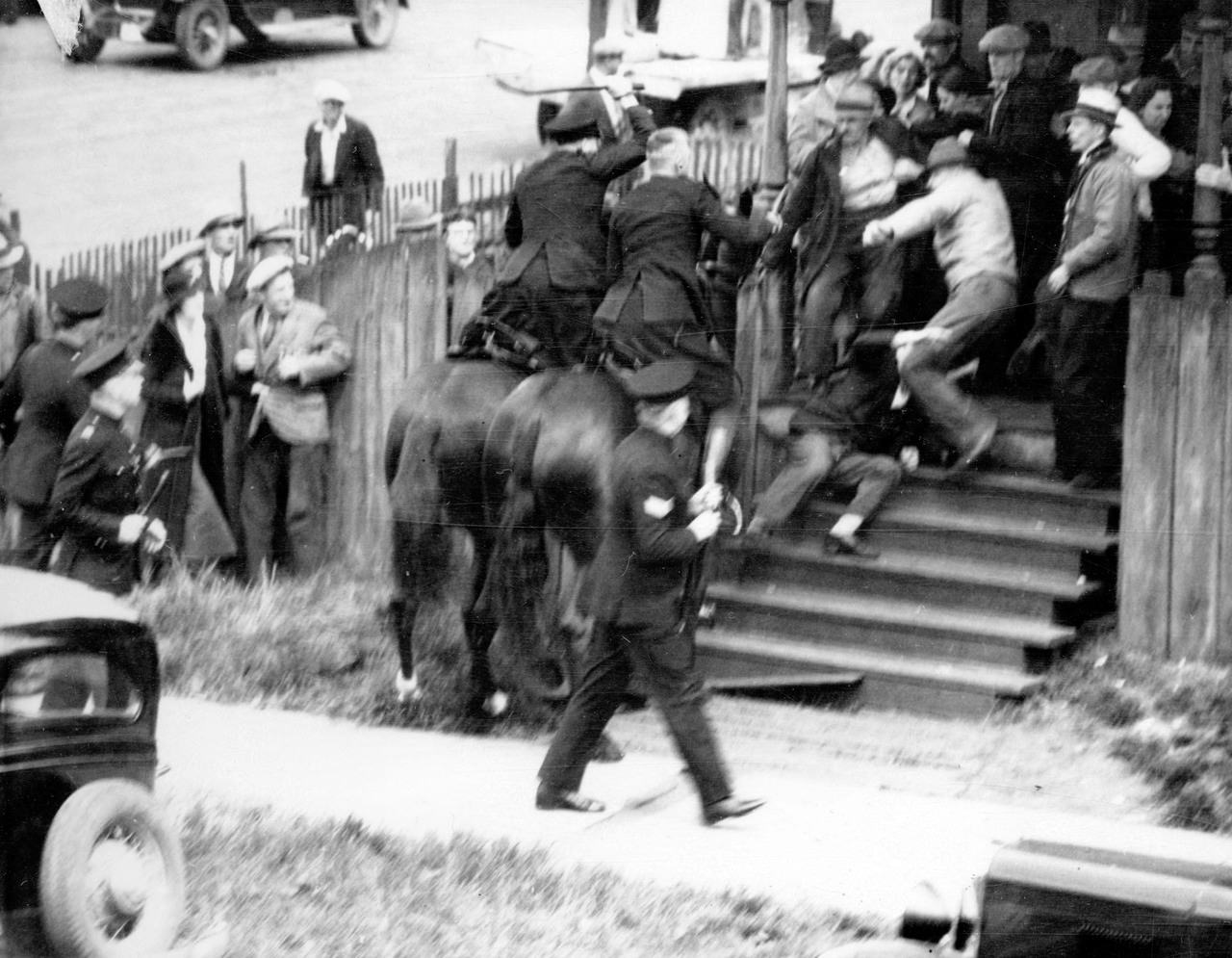 Officers hit striking workers during the Battle of Ballantyne Pier in Vancouver, Canada in 1935. During the Great Depression, dock workers began to strike to push for better wages and more support from the government who owned the dock. These workers already had a history of conflicts with the government in Vancouver, with at least 2 other major strikes in the previous 20 years. Vancouver city officials responded to the growing number of potential protesters by increasing their police force. They refused to allow them to actually protest or carry signs, and tried to encourage them to disperse. Instead, about 1,000 men marched together preparing to demonstrate in front of the pier. The Vancouver police setup an ambush for them. They attacked the crowd with clubs, using mounted police to surround and trap some of the workers, which this picture shows. This attempted strike completely failed, with 60 people being wounded in the battle, none being policemen. Another 24 workers were arrested, and the mayor of Vancouver eliminated relief payments to all known workers participating in the demonstration. The fight for worker rights continued, but would take another 10 years before they would be allowed to form an independent union and get the protections they deserved from the city government.
Officers hit striking workers during the Battle of Ballantyne Pier in Vancouver, Canada in 1935. During the Great Depression, dock workers began to strike to push for better wages and more support from the government who owned the dock. These workers already had a history of conflicts with the government in Vancouver, with at least 2 other major strikes in the previous 20 years. Vancouver city officials responded to the growing number of potential protesters by increasing their police force. They refused to allow them to actually protest or carry signs, and tried to encourage them to disperse. Instead, about 1,000 men marched together preparing to demonstrate in front of the pier. The Vancouver police setup an ambush for them. They attacked the crowd with clubs, using mounted police to surround and trap some of the workers, which this picture shows. This attempted strike completely failed, with 60 people being wounded in the battle, none being policemen. Another 24 workers were arrested, and the mayor of Vancouver eliminated relief payments to all known workers participating in the demonstration. The fight for worker rights continued, but would take another 10 years before they would be allowed to form an independent union and get the protections they deserved from the city government. -
13.
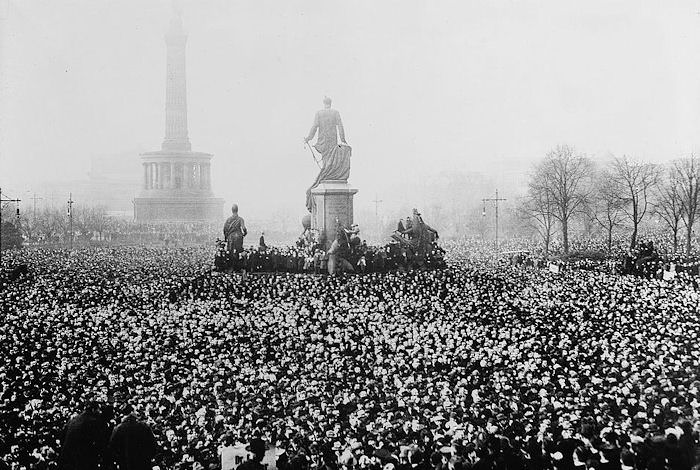 Germans in Berlin stage a mass protest on the Königsplatz on January 14, 1923, in reaction to the French occupation of the Ruhr. The protest occurred amid fears by German officials that angry mobs might storm the French Embassy in Berlin. The Embassy became a focal point of German resentment with crowds gathering there to sing Deutschland Über Alles, the German national anthem (Germany Above All) as an affront to the French personnel inside. The Treaty of Versaille and the aftermath attitude towards the German people by neighboring countries, especially France, after WWI caused lots of demonstrations and attempts to overthrow and restructure the post WWI German government, including by a younger Adolf Hitler. It would take the Great Depression for the outside movements like the Nazis to finally gain enough support to takeover, but Germany had turmoil for much of the 1920s which only fueled the angry populace and eventual support for a united and strong independent Germany which was a major message of the Nazis during rallies.
Germans in Berlin stage a mass protest on the Königsplatz on January 14, 1923, in reaction to the French occupation of the Ruhr. The protest occurred amid fears by German officials that angry mobs might storm the French Embassy in Berlin. The Embassy became a focal point of German resentment with crowds gathering there to sing Deutschland Über Alles, the German national anthem (Germany Above All) as an affront to the French personnel inside. The Treaty of Versaille and the aftermath attitude towards the German people by neighboring countries, especially France, after WWI caused lots of demonstrations and attempts to overthrow and restructure the post WWI German government, including by a younger Adolf Hitler. It would take the Great Depression for the outside movements like the Nazis to finally gain enough support to takeover, but Germany had turmoil for much of the 1920s which only fueled the angry populace and eventual support for a united and strong independent Germany which was a major message of the Nazis during rallies. -
14.
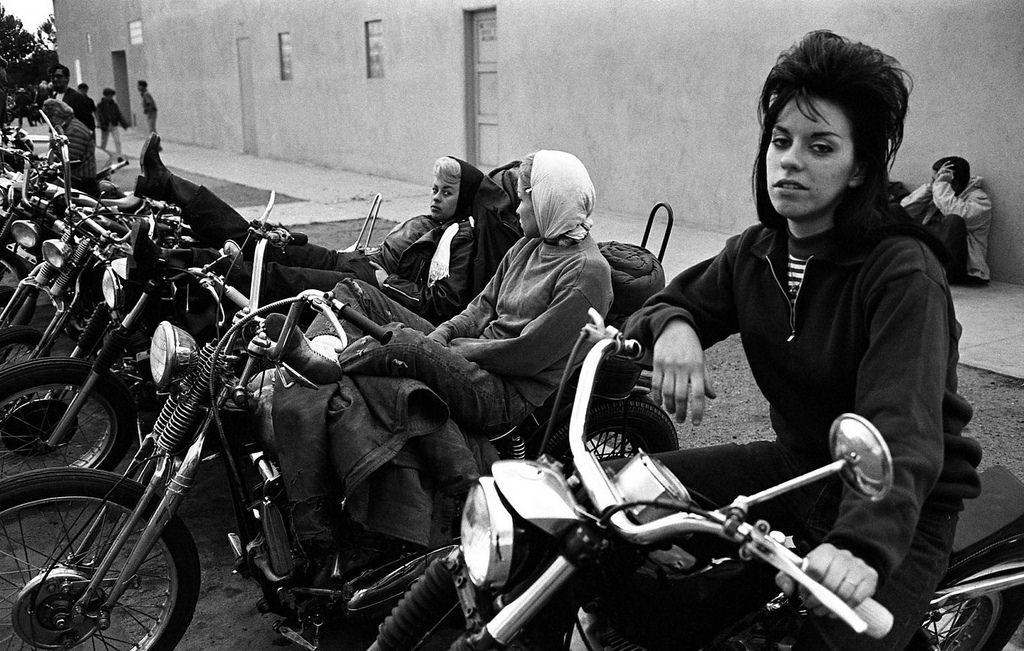 Female bikers hanging out at a rest stop on the road in California, US in 1965. Motorcycle groups or gangs have existed nearly as long as the motorcycle itself. What may surprise you is many women rode motorcycles for shows doing stunt work as well as in groups or gangs in large numbers since the 1920s. Many also participated in large rides, and even female celebrities would ride and collect motorcycles. Such actresses from the 1920s-1960s include big names such as Ann Margret, Brigitte Bardot, Easter Walters, Honor Blackman, and Jane Asher.
Female bikers hanging out at a rest stop on the road in California, US in 1965. Motorcycle groups or gangs have existed nearly as long as the motorcycle itself. What may surprise you is many women rode motorcycles for shows doing stunt work as well as in groups or gangs in large numbers since the 1920s. Many also participated in large rides, and even female celebrities would ride and collect motorcycles. Such actresses from the 1920s-1960s include big names such as Ann Margret, Brigitte Bardot, Easter Walters, Honor Blackman, and Jane Asher. -
15.
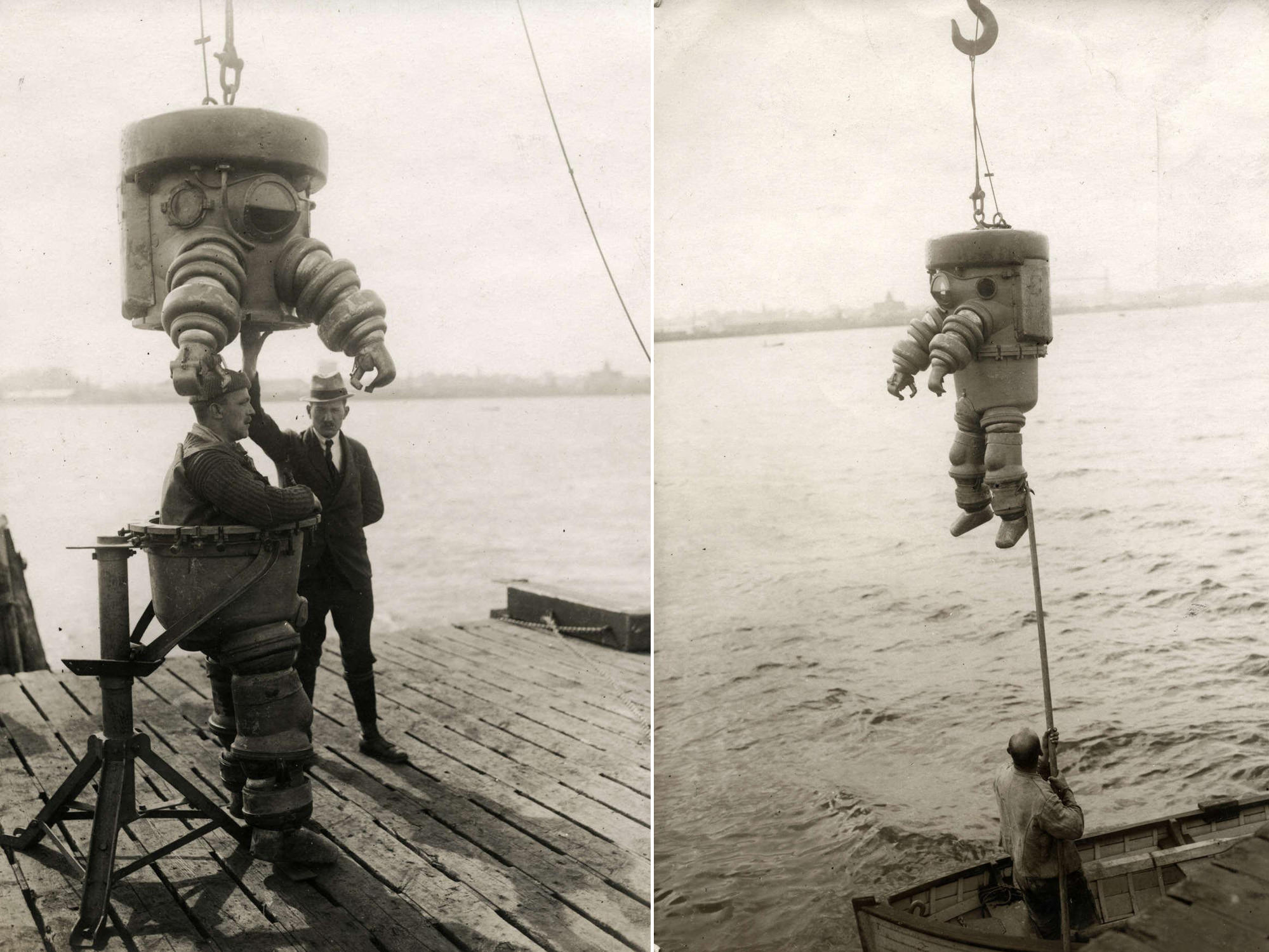 A man puts on his diving suit that was made by the Neufeldt & Kuhnke company of Kiel, Germany in 1922. Most early diving suits were huge metal suits, and were incredibly heavy. As this picture shows, the diver is unable to move in the suit outside of water since it is so bulky and heavy. Salvage and repair were often the reason for diving suits, and testing them was dangerous, with numerous fatalities due to failure as well as communication with someone in such a suit below water was incredibly difficult. Diving suits of these kind are about 200 years old, and are still being adjusted for certain depths to this day.
A man puts on his diving suit that was made by the Neufeldt & Kuhnke company of Kiel, Germany in 1922. Most early diving suits were huge metal suits, and were incredibly heavy. As this picture shows, the diver is unable to move in the suit outside of water since it is so bulky and heavy. Salvage and repair were often the reason for diving suits, and testing them was dangerous, with numerous fatalities due to failure as well as communication with someone in such a suit below water was incredibly difficult. Diving suits of these kind are about 200 years old, and are still being adjusted for certain depths to this day. -
16.
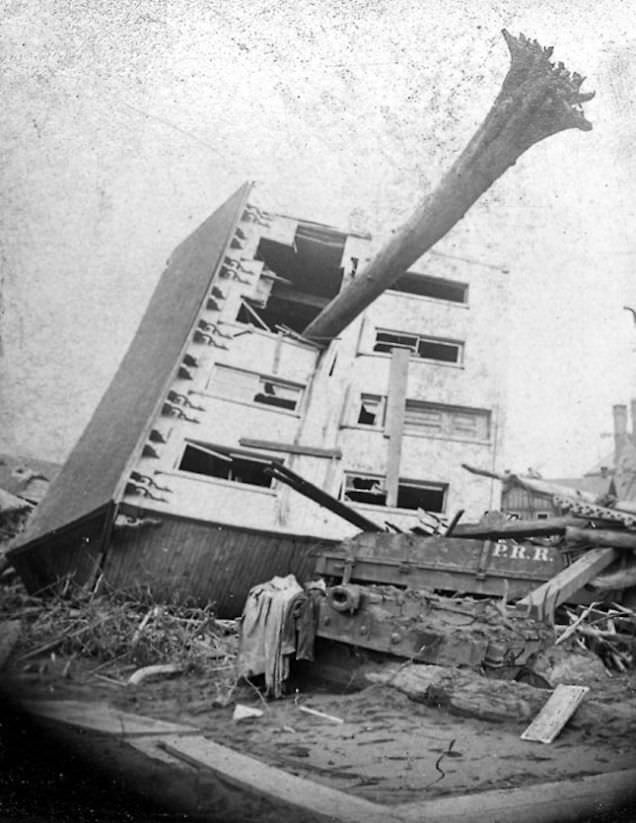 A destroyed home after the failure of the South Fork Dam on Lake Conemaugh, near South Fork, Pennsylvania, US on May 31, 1889. After a few days of heavy rainfall, the damn suffered a complete failure. Around 14.55 million cubic meters of water was released on the town of Johnstown, sweeping entire homes away in a single hit. Pictures like this are not of homes toppled over, but homes that floating some miles away, with other properties obliterated entirely. The disaster killed 2,209 people, and left virtually the entire town of Johnstown, Pennsylvania homeless. Clara Barton, founded of the American Red Cross, lead the relief effort. 18 other countries actually helped as well, feeding, housing, and getting the survivors back on their feet. This event also helped the US change laws towards liability of business owners. The dam was privately owned, and lawsuits against them failed. The public was furious and it forced the US to change the law from a fault-based regime to strict liability.
A destroyed home after the failure of the South Fork Dam on Lake Conemaugh, near South Fork, Pennsylvania, US on May 31, 1889. After a few days of heavy rainfall, the damn suffered a complete failure. Around 14.55 million cubic meters of water was released on the town of Johnstown, sweeping entire homes away in a single hit. Pictures like this are not of homes toppled over, but homes that floating some miles away, with other properties obliterated entirely. The disaster killed 2,209 people, and left virtually the entire town of Johnstown, Pennsylvania homeless. Clara Barton, founded of the American Red Cross, lead the relief effort. 18 other countries actually helped as well, feeding, housing, and getting the survivors back on their feet. This event also helped the US change laws towards liability of business owners. The dam was privately owned, and lawsuits against them failed. The public was furious and it forced the US to change the law from a fault-based regime to strict liability. -
17.
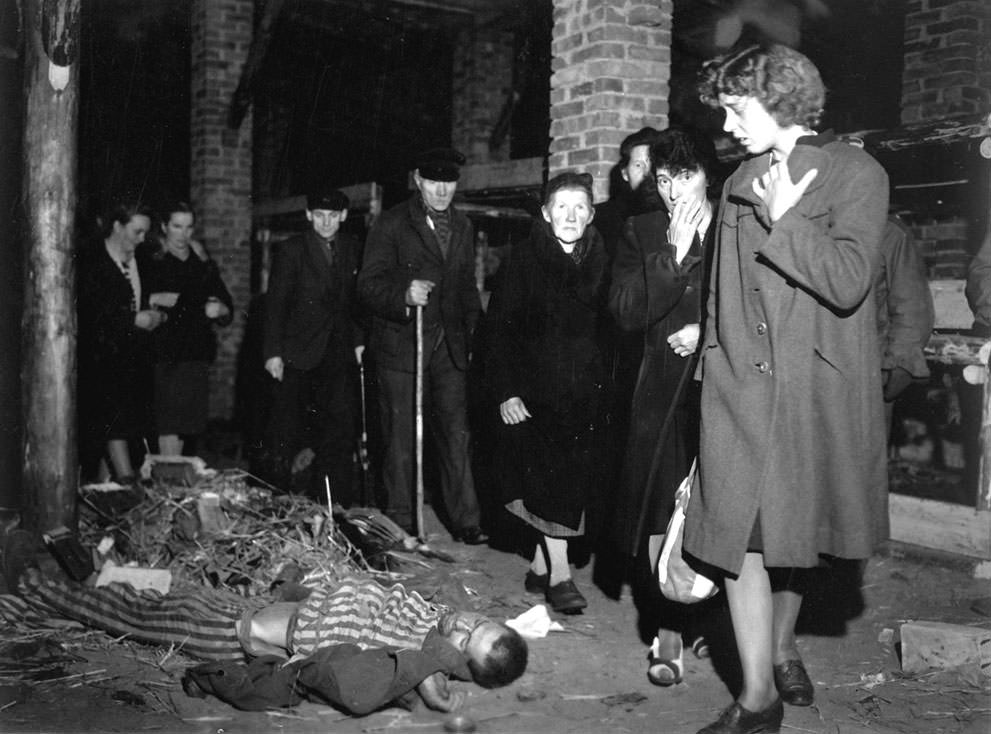 Citizens of Ludwigslust, Germany, inspect a nearby concentration camp under orders of the 82nd Airborne Division in preparation for its cleanup on May 6, 1945. Bodies of victims of the German concentration camps were found dumped in pits in the yard with one pit containing at least 300 bodies. Many victims were killed before the guards ran off, setting fire to areas as well. When the US forces found many of the concentration camps in Germany, they were shocked the locals in towns near them usually claimed they didn't even know it existed. As a response to that, the US forced the local businesses to supply food and rations for the survivors, then forced the citizens to clean up the dead at the camps. This put the bodies of the victims of the holocaust face to face with German citizens who either supported the camps or were complicit in their operations. The faces on the ladies on the right is what many of the citizens experienced after seeing these horrors up front. It is important to note many Germans did not agree with the Nazis. In fact, a lot of German citizens who survived the war who had to clean up such camps had severe breakdowns and some even committed suicide.
Citizens of Ludwigslust, Germany, inspect a nearby concentration camp under orders of the 82nd Airborne Division in preparation for its cleanup on May 6, 1945. Bodies of victims of the German concentration camps were found dumped in pits in the yard with one pit containing at least 300 bodies. Many victims were killed before the guards ran off, setting fire to areas as well. When the US forces found many of the concentration camps in Germany, they were shocked the locals in towns near them usually claimed they didn't even know it existed. As a response to that, the US forced the local businesses to supply food and rations for the survivors, then forced the citizens to clean up the dead at the camps. This put the bodies of the victims of the holocaust face to face with German citizens who either supported the camps or were complicit in their operations. The faces on the ladies on the right is what many of the citizens experienced after seeing these horrors up front. It is important to note many Germans did not agree with the Nazis. In fact, a lot of German citizens who survived the war who had to clean up such camps had severe breakdowns and some even committed suicide. -
18.
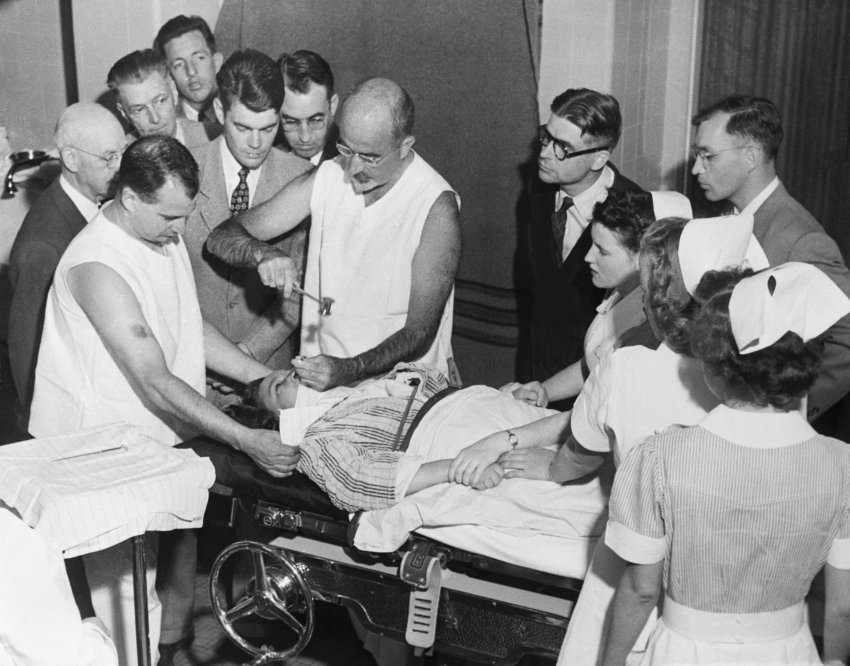 Walter Freeman performing his trademark ice pick lobotomy on a patient in 1956. Freeman traveled the US performing lobotomies for mental patients and others for just $25. He became famous for this. He did not need a neurosurgeon nor did he need much for his procedure. What he would do was insert a metal pick into the corner of each eye-socket, hammering it through the thin bone, and moving it back and forth, which would sever the connections to the prefrontal cortex in the frontal lobes of the brain. He even did this for John and Robert Kennedy's sister Rosemary. The technique was widely criticized, but Freeman continued for 40 years, performing over 4,000 lobotomies with at least 2,500 using this technique. Freeman was not a doctor by the way, and he never took formal surgical training. Worse yet, around 40% of his patients were gay, and the procedure were forced on them by their families to change their sexual orientation. Most patients sadly suffered mental issues after this procedure. That means this guy changed perfectly healthy people to severely disabled with his procedure in an attempt to make them straight or for others making their existing mental issues just that much worse.
Walter Freeman performing his trademark ice pick lobotomy on a patient in 1956. Freeman traveled the US performing lobotomies for mental patients and others for just $25. He became famous for this. He did not need a neurosurgeon nor did he need much for his procedure. What he would do was insert a metal pick into the corner of each eye-socket, hammering it through the thin bone, and moving it back and forth, which would sever the connections to the prefrontal cortex in the frontal lobes of the brain. He even did this for John and Robert Kennedy's sister Rosemary. The technique was widely criticized, but Freeman continued for 40 years, performing over 4,000 lobotomies with at least 2,500 using this technique. Freeman was not a doctor by the way, and he never took formal surgical training. Worse yet, around 40% of his patients were gay, and the procedure were forced on them by their families to change their sexual orientation. Most patients sadly suffered mental issues after this procedure. That means this guy changed perfectly healthy people to severely disabled with his procedure in an attempt to make them straight or for others making their existing mental issues just that much worse. -
19.
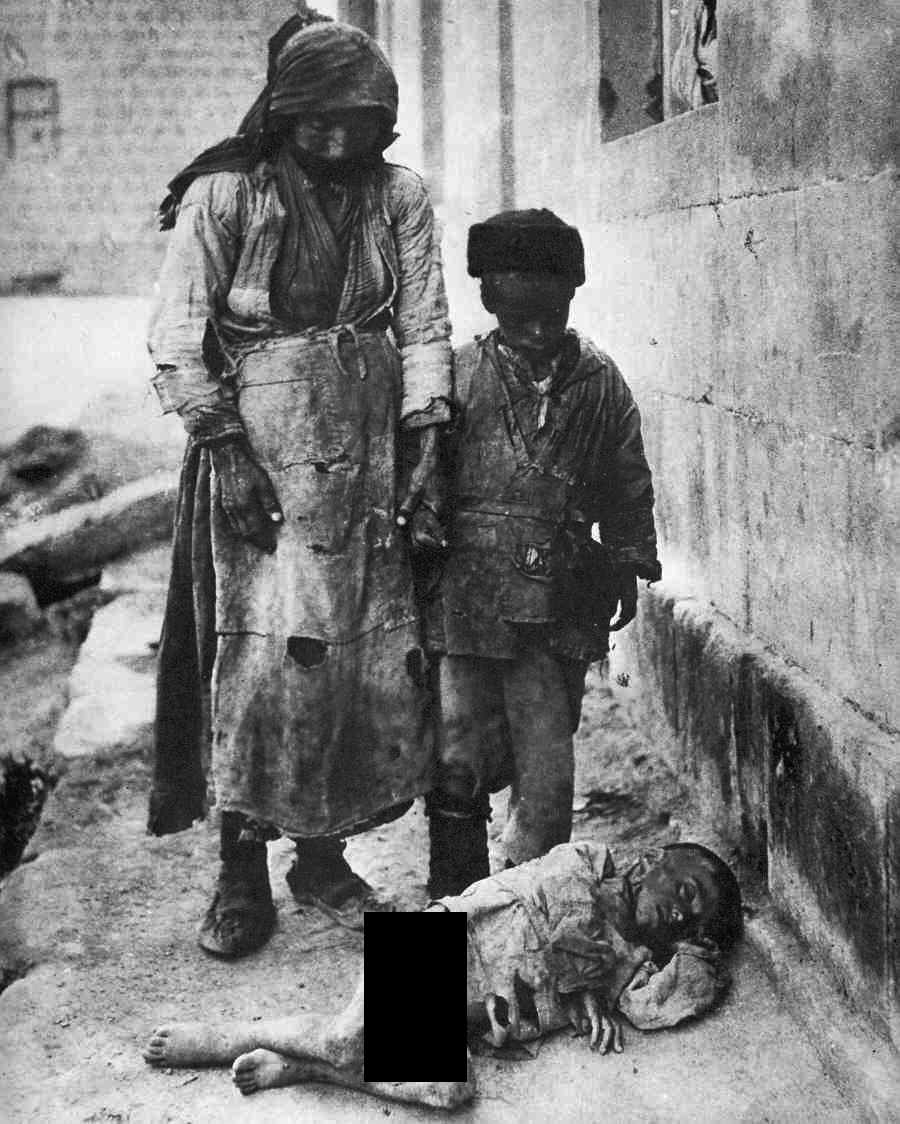 A mother and her son check to see if this fallen child is alive as they are being deported from an area in Turkey during the Armenian Genocide in 1915. The child was alive, but too weak to walk, and like many other starving children during forced relocations at this time, most likely was left to die. The Ottoman Turk forces took over Armenian towns as early as 1914 and forced relocated them throughout WWI and even as late as 1923. They would often just kill the men and starve the women and children. This picture, and a few others like it, were smuggled out to the West, mainly by Swedish missionaries, in an attempt to bring this situation to light throughout the world. The extent of the genocide was not entirely known during WWI, and the allied leaders were busy handling Germany and Austria-Hungary, Russia's internal collapse, mutinies in France, and other issues, allowing the Turks to freely continue the annihilation of the Armenians. Those that escaped being rounded up or killed fled to areas like Syria, often dying on the treacherous journey. All told, it is estimated 1.5 million Armenians were killed. The Ottoman empire collapsed and was dissolved shortly after WWI. The new Turkish state post WWI and even Turkey today refuses to fully acknowledge the genocide ever happened. Unfortunately none of the leaders behind this orchestrated and systematic elimination of a people ever saw justice.
A mother and her son check to see if this fallen child is alive as they are being deported from an area in Turkey during the Armenian Genocide in 1915. The child was alive, but too weak to walk, and like many other starving children during forced relocations at this time, most likely was left to die. The Ottoman Turk forces took over Armenian towns as early as 1914 and forced relocated them throughout WWI and even as late as 1923. They would often just kill the men and starve the women and children. This picture, and a few others like it, were smuggled out to the West, mainly by Swedish missionaries, in an attempt to bring this situation to light throughout the world. The extent of the genocide was not entirely known during WWI, and the allied leaders were busy handling Germany and Austria-Hungary, Russia's internal collapse, mutinies in France, and other issues, allowing the Turks to freely continue the annihilation of the Armenians. Those that escaped being rounded up or killed fled to areas like Syria, often dying on the treacherous journey. All told, it is estimated 1.5 million Armenians were killed. The Ottoman empire collapsed and was dissolved shortly after WWI. The new Turkish state post WWI and even Turkey today refuses to fully acknowledge the genocide ever happened. Unfortunately none of the leaders behind this orchestrated and systematic elimination of a people ever saw justice. -
20.
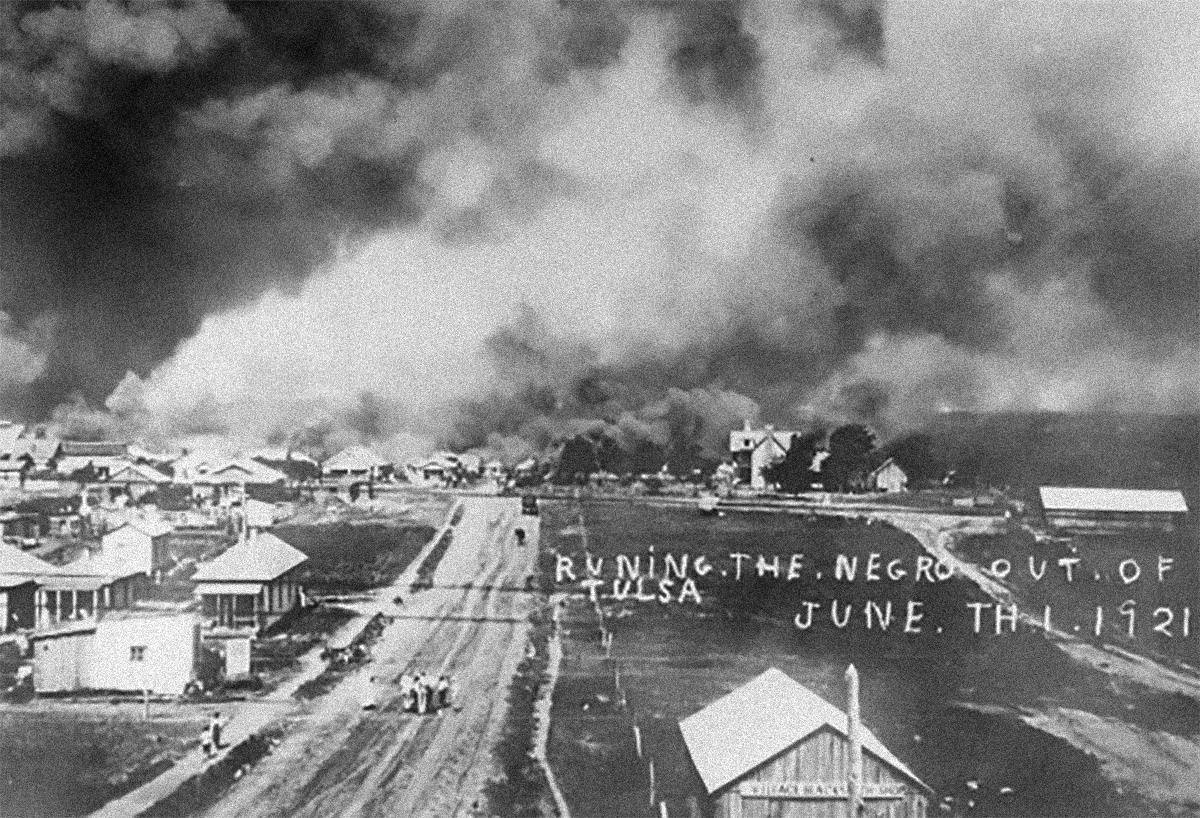 A picture of the black residential area of Tulsa on fire during the Tulsa Race Riot in Oklahoma, US in 1921. The cause of the riot started when a young 19 black man Dick Rowland was accused of assaulting a 17 year old white woman, Sarah Page. Using the word assault when described against a women in 1921 was also the term for rape. Despite no real evidence with even the young girl not making such a claim nor trying to press charges, Dick Rowland was detained and taken to the court house. Soon after a lynch mob developed. The sheriff of Tulsa did a terrific job not letting the mob get the young man, who survived the ordeal. White officers put their own lives on the line in a racially segregated South prepared to gun down intruders to avoid a lynching of a young black man. It worked, however it had terrible unknown consequences. Fearful of the lynch mob succeeding, black community members armed themselves. They kept offering to help the officers but knowing what a bad idea that was, the sheriff turned those offers down. Seeing armed black men, the crowd of over 2,000 white people, mostly males, armed up themselves. Eventually a small race battle ensued. For 3 days armed conflicts between whites and blacks commenced. In the process, the white mobs shot every black person they saw at times, and burned down the very wealthy black communities businesses and homes. They even used privately owned planes to recon and attack the areas with incendiary bombs. The National Guard went in to issue martial law and they were fired upon by both sides. Once everything was quelled, up to 300 people were dead, estimated around 250 or so being black, most unarmed and caught in the conflict. Most of the black community known as "Black Wall Street" was destroyed, with thousands of blacks fled the city, never returning. That note is a good reason for the words written on this picture, even though, ironically, the poor spelling is evident.
A picture of the black residential area of Tulsa on fire during the Tulsa Race Riot in Oklahoma, US in 1921. The cause of the riot started when a young 19 black man Dick Rowland was accused of assaulting a 17 year old white woman, Sarah Page. Using the word assault when described against a women in 1921 was also the term for rape. Despite no real evidence with even the young girl not making such a claim nor trying to press charges, Dick Rowland was detained and taken to the court house. Soon after a lynch mob developed. The sheriff of Tulsa did a terrific job not letting the mob get the young man, who survived the ordeal. White officers put their own lives on the line in a racially segregated South prepared to gun down intruders to avoid a lynching of a young black man. It worked, however it had terrible unknown consequences. Fearful of the lynch mob succeeding, black community members armed themselves. They kept offering to help the officers but knowing what a bad idea that was, the sheriff turned those offers down. Seeing armed black men, the crowd of over 2,000 white people, mostly males, armed up themselves. Eventually a small race battle ensued. For 3 days armed conflicts between whites and blacks commenced. In the process, the white mobs shot every black person they saw at times, and burned down the very wealthy black communities businesses and homes. They even used privately owned planes to recon and attack the areas with incendiary bombs. The National Guard went in to issue martial law and they were fired upon by both sides. Once everything was quelled, up to 300 people were dead, estimated around 250 or so being black, most unarmed and caught in the conflict. Most of the black community known as "Black Wall Street" was destroyed, with thousands of blacks fled the city, never returning. That note is a good reason for the words written on this picture, even though, ironically, the poor spelling is evident.
- NEXT GALLERY
-

- 25 Of The Best Simpsons Quotes Of All Time!
Contestants getting ready for the Miss Soviet Union pageant near a statue of Vladimir Lenin in Moscow, USSR in 1988. This is the first beauty pageant of any kind in the Soviet Union since they were banned in 1959. The USSR had a history of rather conservative views, outlawing anything they deemed too much for long stretches before they collapsed. This including provocative attire or even certain Western clothing, homosexuality, dance and strip clubs, pornography, and plenty more. In the 1980s the USSR removed some of those restrictions, such as beauty pageants. After the collapse and transition to democracy, much more would be allowed throughout Russia and the many countries created afterwards.
20/20
1/20
Categories:
Wow


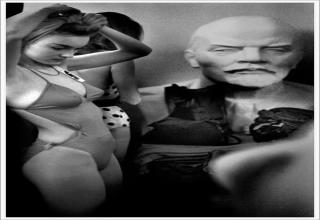
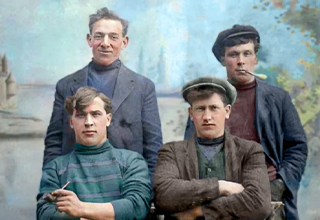





1 Comments